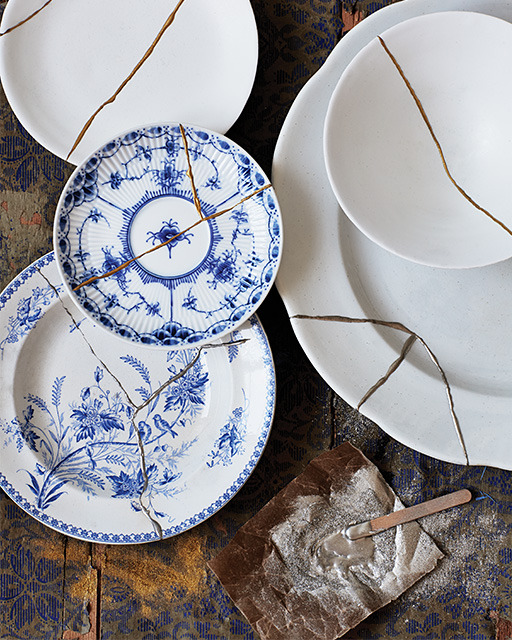Legend has it that the Japanese shōgun, Ashikaga Yoshimasa sent a much loved, but damaged tea bowl back to China for repairs. It was returned with metal staples bolting the broken pieces together which did not please the shōgun. He urged local Japanese craftsmen to search for a more aesthetic manner in which to repair the bowl. They chose to use lacquer to bond the pieces together and then dusted the lacquer with gold powder. The cracks of the repair therefore became part of the object, and so the art of kintsugi was born. Kintsugi makes no attempt to hide damage, instead the damage is illuminated and exalted, making the object more beautiful because of the faults.
If breakage and repair is merely part of the history of an object, it might be analogous that failure and disappointment might be an equally beautiful part of our histories that require better praise. The vicissitudes of existence will leave their mark no matter how we might earnestly strive for unachievable perfection. Our unsuccessful attempts at life are, no matter how we might sweep them under the carpet, part of our identity. Perhaps if the lexicon of failure weren’t so synonymous with shame people and organisations would better value the marks of failure.
No matter how desirable a particular intended outcome might be, we don’t always meet that mark. Interestingly enough, the etymology for the word ‘sin’ is ‘to miss the mark’. Package that definition up with some Abrahamic ethics and the catalogue of mortal errors and it’s no wonder that many Western people run from failure with all the imagined terror of eternal damnation. Our response to failure could alter if we examined the belief system we have coupled with the concept.
Very few of us would have been raised in cultures that exalted failure. Once we move beyond the loving encouragement of the toddler years where our clumsy attempts at walking and talking are bolstered and applauded, we enter into the domain of learning what’s good enough. We are placed on a series of normal distribution curves that compare our height, weight, academic performance and sporting prowess. We start to receive report cards that grade us and judge us as below, above or on-par. We internalise a barometer of acceptable success.
The way others respond to us when we don’t reach their measure of success for us starts to further shape how we see ourselves. In order to feel loveable and acceptable and welcomed there starts to emerge a particular shape we should inhabit. We mould our beings towards that outline. So, when hardship, heartache and heartbreak come visiting it’s no wonder our identities retreat into defensiveness or denial. Failure is not often the life you dreamed for yourself.
A culture that denigrates failure is a culture that limits creativity. Once tried and tested processes are found those sort of cultures stick with them, fearing deviation because it might just transport them to the edges of life’s disarray. Lacking imagination to envision a new way of doing things, a better way of seeing yourself or a novel approach for how to embrace life equals a life devoid of creativity, which is not really living at all.
Learning who you are and what you are about is equally as important as knowing who you are not what you do not stand for. It matters to be kind and generous as much as it matters that you are not unkind and not selfish. Failure can become a masterful, albeit merciless, guide in this regard. Failure strips away the non-essential. When we know what doesn’t work, when we have understood how not to do something and what can no longer work we can begin envisioning that which is not. We can imagine something better.
Finding useful criteria for the evaluation of success is where the possibility for a mental shift can occur. Perspective is everything. From a certain point of view and time in history Apartheid was deemed successful. With enough distance from our early heartbreaks we can move to saying to ourselves, ‘what was I thinking?’ And that’s the key – continually examine what are you thinking.
We know that we all have this amazing superpower – if we change our thoughts about a person or a situation or ourselves the thing itself transforms. Bad situations, complicated people and painful memories can transmute themselves just by thinking differently. The power works both ways, however. We can also make good situations and worthy people turn negative with a change of thought.
Blunders may not always be manageable and when we are required to go to ground to re-evaluate our attempts a ‘trial and error’ heuristic is the most useful method of evaluation. Success and failure are weighty evaluators: too extreme on the scale of duality. A kinder middle path would be to say ‘what’s working and what’s not?’ The trick is knowing when to call that you’re done. How long do we stay the course: making that relationship work, believing your ship will come in, trusting the life path you are on is right?
Hope requires a healthy grasp of reality. Being uniformed about our reality or holding onto a distorted view of reality or indeed just denying what is really happening will lead us toward false hope and potential helplessness. Facing our reality drives us towards real hope. With goals in mind, a sense of agency about our lives and a flexible and imaginative mindset towards the path that will get us to those goals allows us to place failure within a context. We know when to surrender when we are facing our reality with honesty.
Inevitably errors will be made. Knowing that failure during a lifetime is guaranteed should in fact be liberating. How we go about repairing the breaks and cracks of our ideal selves is what will be the most illuminating aspect of our lives. If, like a kintsugi ceramic you can emblazon the world with your known faults displayed in all their glory you become a vitalising energy for all. You teach the world that living is a creative act and how we reimagine our lives after setbacks should glow because they are the marks of hard won, golden wisdom. They are the marks of living.
“It is impossible to live without failing at something, unless you live so cautiously that you might as well not have lived at all— in which case, you fail by default.”
J.K. Rowling







I love this, Cal. Well done!
Thank you – glad you enjoyed it